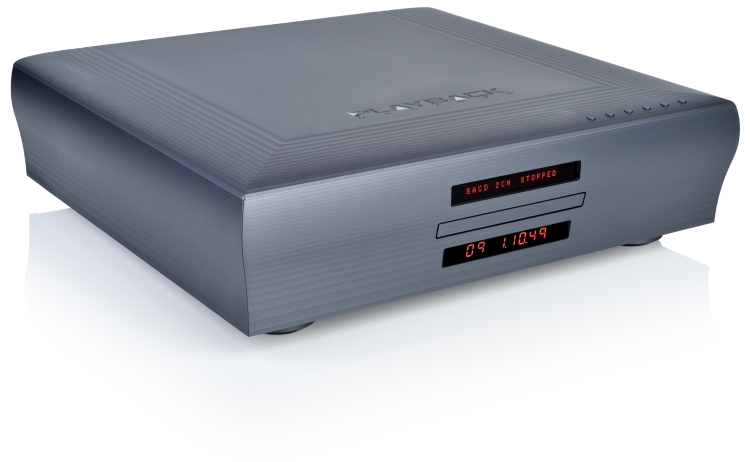Musical Fidelity Clic
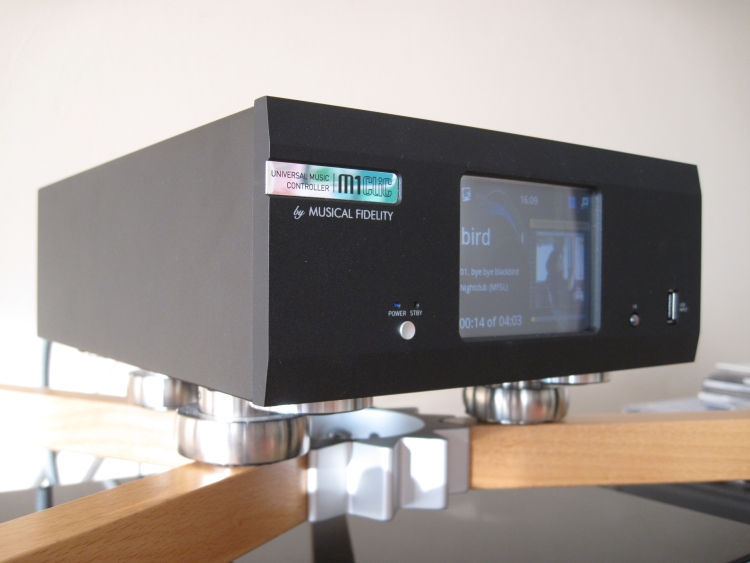
Comparable in size to the Naim UnitiQute, the Musical Fidelity Clic promises even wider compatibility, albeit without built-in amplifier
Review sample supplied by Dutch distributor Viertron
Retail price approx 1499 euro
Here’s Musical Fidelity’s first step into the ever more popular world of Streaming Audio. By adding a Stream Unlimited module to their M1 DAC as well as adding more connectivity, they have created a device that has so much functionality that it can be difficult to put it into any single category. For starters, it is, of course, a regular DAC in the sense that it offers regular digital inputs (2 coax and 1 toslink). But it also has a USB input for direct connection of PC and Mac. Second, it is a UPnP streamer that will connect to any UPnP compatible hardware. That could be a NAS or a Windows or Mac computer running a program that acts as a server, such as Windows Media Player or PS Audio’s eLyric. Still under the second header is the Clic’s ability to play from USB stick or USB hard drive directly, as long as they’re FAT-formatted. Third, the Clic is also a preamplifier with three analog inputs, a tape out (also used as line out into a separate preamp) and a pre out for connecting to a power amp.
So what kind of a device is the Clic? A preamp with digital inputs? A DAC with streaming functionality? A streamer with analog inputs? Well, it is all those things. And more: it even has an iPod/iPad/iPhone connection.
An i-device can actually only be connected directly on the rear, without intervention of a dock. As I found out later, the front panel input is only for USB drives. There’s more about connecting i-devices further below.
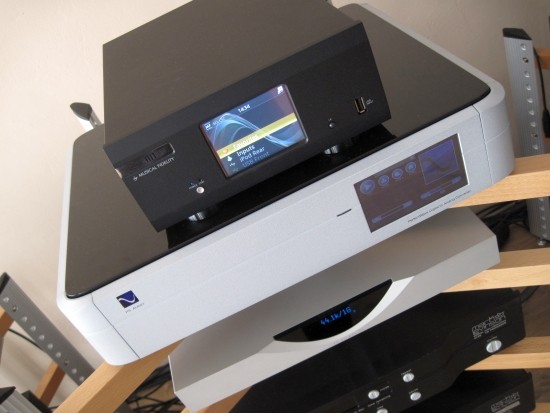
As regular readers already know, I am always most interested in the soundquality and tend to focus mainly on DAC quality and Streaming quality. Although the Clic has lots more functionality than this, in my view however, its main purpose is streaming, so I’d like to emphasize on that aspect.
I should write a little bit about its preamp functionality though. What you should know is that the front panel display is not a touch screen and the Clic’s frontpanel has no buttons except for power. All control goes via IR remote. This works well and although not lightning-fast, is quick enough. The thing is that unless you have laser-vision, or sit really close to the device, it can be difficult to tell what’s going on from the listening position. Admittedly I sit 7 meters away, and in this situation I find the preamp functionality a little less than convenient. Volume control and track skip are easy enough because there are separate buttons for that on the IR remote. Input selection as well as browsing through UPnP directories however isn’t really possible unless you are close to the unit.
Whether or not you should choose to use the Clic’s preamp functionality and associated analog connectivity is very much dependent on personal choice, budget and WAF. WAF? Yes, Wife Acceptance Factor can certainly be in effect when trying to minimize one’s number of components. It depends on personal choice because you may yourself feel that Less Is More and finally budget comes into play for obvious reasons. While the preamp functionality works well and sounds fine at the price, there really is a lot of profit to be had when using an integrated amplifier or separate preamp. The streaming- and DAC quality is certainly good enough to justify further investment.
Of course its UPnP compatibility ensures that the Clic can also be operated via iPod, iPhone or iPad. Musical Fidelity doesn’t have their own app but there are several universal ones to choose from, such as Plug Player or eLyric. Any of these apps work well and allow easy operation from the couch. Do note however that it is not possible to change volume or input selection with the app.
Regular readers also know that I like to make lots of comparisons, unfair comparisons even. Such as a comparison with the PS Audio PWD. In this case the Clic has extra-heavy competition because I finally decided to buy a Linn Klimax DS and received it a week ago. The Klimax DS is widely regarded as the best in streaming audio replay, and as such it will be the absolute against which the Clic will have to show what it’s capable of. Unfair competition, for sure. But I will also compare the Clic’s streaming replay to the sound of a Windows computer, connected via USB/SPDIF interface to the resident Levinson 360S DAC. Unfair again? Maybe, so I’ll also compare the aforementioned computer replay straight into the Clic, thereby assessing its M1 DAC quality. To put it all into perspective, I’ll do some comparisons (in retrospect) with the Naim Uniti and UnitiQute that I had in for review a little while ago. Also, the Clic’s overall performance will be compared to a number of resident CD players, in a wide price range.
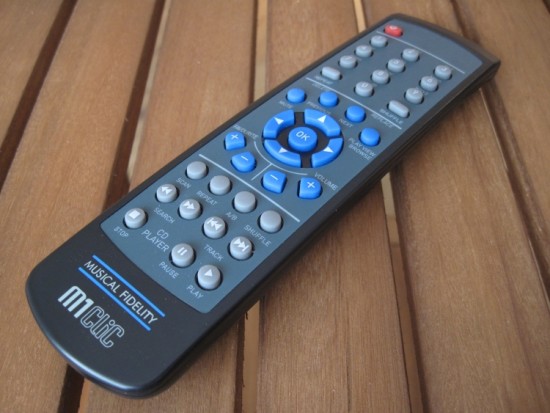
Above: the Clic’s IR remote control is complete and ergonomic. I was looking for the stop button until I realized that the OK button functions as such during playback.
One more technicality then, before we move on to the listening tests. The Clic’s i-device functionality. The manual states compatibility with iPod touch, iPhone 4, iPhone 3G and iPhone 3GS. The manual further states “extended mode supported” but I have no clue what that means. When I first connected my iPhone 4, with which the Clic is compatible, it wasn’t recognized, the display showing an error message. I then tried the front panel input but the same happened. After a software update, initiated from the IR remote and done in minutes, all of a sudden it worked flawlessly. I also tried an iPad 2 and although I don’t have any music on it, it seemed to interface just fine, me being able to browse the default ipod directory and the iPad showing an “Accessory Connected” message.
Upon connecting the iPhone 4, the phone displays an “Accessory connected” message and can no longer be controlled in the usual fashion. Instead, it can be operated by IR remote, selecting playlists, songs, artists and all other usual iPod categories. It is however not possible to control the iPhone remotely with the iPad, like with the Naim UnitiQute. For this to work you’d need an app especially conceived for the Clic.
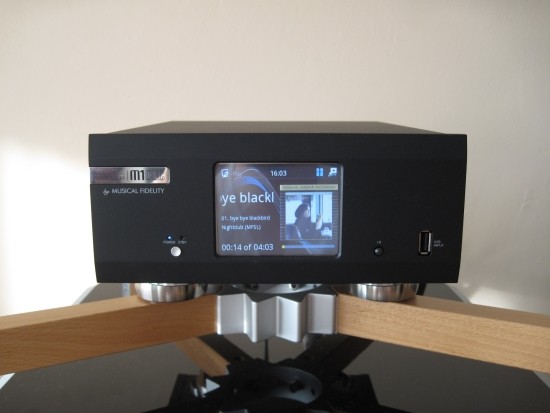
Sound Quality
Clic used as a DAC
I tried several CD players as a source, of note were the Marantz CD80 (a 20-year old classic) and the Marantz CD4000 (an older entry level player). First up was the CD80 which I like because of its great transport. The CD80 itself has a somewhat flat and undynamic sound but is otherwise very smooth and liquid. Connected coaxially to the Clic, the sound changes positively, now being more colorful, bigger and even smoother. Speed is not a CD80 forte, but connected to the Clic this doesn’t really improve.
Next up is the Marantz CD4000. Several years old now, and nothing special, this was nevertheless very good value for money at the time. The CD4000 has a very upbeat sound and is natural enough but it can be accused of some coarseness and lack of subtlety. Connected coaxially to the Clic the sound changes a lot. There’s a lot more smoothness with the treble being much creamier, midrange more royal and the delivery is more nuanced, more refined. But it isn’t all good because the bass, nice and bouncy before, was now a bit fat and slower. Also dynamics were flatter, the result being a less lively sound.
I couldn’t resist connecting the Levinson 390S cd player to the Clic and this was an interesting comparison. On the one hand it was now evident that the Clic is very refined, having a treble delivery that was at least as good as the Levinson’s. Also it sounds very natural, not synthetic/plasticky at all and has excellent detail retrieval. Lastly, it has a neutral tonal balance and is less colorful/full than the Levinson. What also became clear that the Clic sounds somewhat constrained both dynamically and spatially. It is sometimes a little too relaxed and its soundstage isn’t very expansive. Its timing is allright but it doesn’t have the greatest PRAT in the world.
Clic used as a Streamer
Streaming various music in various formats (wav/flac/mp3) from the Synology NAS via wired network cable, the Clic plays faultlessly and uniformly, no matter the format, decoding apparently always results in a comparable sound signature. Most obvious is again its creaminess and air in the treble. This is important to note, as the PS Audio PWD has a definite ceiling in the highest treble and can also be a little rough. The Clic is just very friendly, never harsh. Also evident again is the slightly soft quality in the bass. There’s a lack of expansion, drive and incisiveness, that combines into a pleasant, but somewhat reticent character. Whether functioning as a DAC or a streamer, the sound is always characterized by a high neutrality and a complete lack of aggression. But despite the richness in the (somewhat less than full-) bass, and perhaps because of its politeness, sometimes the sound can also be slightly uninteresting.
Internet Radio
Playing internet radio stations is easy with the Clic. The selection is huge and sound quality is conform to the standard, which is a little less than NAS streaming, with dynamics more crushed and bass softer still. But this is conform the norm, or at least on par with what I hear with most other streamers, the PS Audio PWD included. The only streamer deviating in that area is the Klimax DS.
Clic compared to PS Audio PWD
The PS Audio PWD is a very upbeat, highly dynamic sounding DAC/streamer. The CD80 mentioned above, connected coaxially to the PWD sounds very lively and rhythmic, with much more articulation than through the Clic. But this is also a much drier presentation with a less open and airy treble and more aggression. I actually preferred the Clic’s delivery. What can I say, I’m just a smooth kind of guy. Also, I just can’t get over the PWD’s one less-developed area which is its treble delivery. Where the PWD’s treble is dry and low res, the Clic’s treble is open and airy and superfluid, creamy almost. But when streaming over the network, the PWD gives a little more. Even when its treble ceiling remains, and the treble doesn’t become analogous to that of any of the Marantz or Levinson players here, nevertheless its Digital Lense and associated circuitry obviously does something very well. The PWD has a very solid soundstage that is both wide and deep and perhaps its strongest area is its bass, which is big, deep and very well timed. You should know that I’m also a bit of a bass-guy. The Clic by comparison is a little weak in the bass (although it doesn’t lack depth) and doesn’t offer as wide or deep a soundstage, nor the PWD’s dynamics. But it counters with an easy going presentation that is just very relaxing and sometimes more appealing than the PWD. Further comparisons showed that the Clic’s refined delivery can also sometimes be too much of a good thing, with some music coming across as less interesting than it can be. The Click may deviate from absolute neutrality in terms of bass- and treble softness, all in all I would still say that the Clic is pretty neutral.
Clic compared to Naim UnitiQute (in retrospect)
I planned to make direct comparisons, but due to some delays, the Naim was already back to the dealer. But I have good memory for audio quality and because the Naim was in very recently, I still feel that I can make some valid comparisons. The UnitiQute is a little bit more expensive than the Clic, but it also offers a built-in amplifier. Leaving (pre-) amplifier functionality aside, and focusing only on streaming quality, the Naim impressed mightily with its enthusiastic delivery. It was upbeat and dynamic and highly engaging. Importantly, it managed to do this without sounding coarse. It actually had much better treble than the PWD. But the UnitiQute was also a little colored. Not in a bad way though, and I actually like a little color in the sound, but nevertheless, it had a definite character. Not so the Clic, which is almost character-less in comparison. The Clic may have even more fluid treble than the UnitiQute and it may also be more transparent. But in a deviation from my normal practice, I have to award points to the UnitiQute for having a more complete i-device experience, in that you can control the docked i-device’s entire directory with the app on the ipad from the listening position.
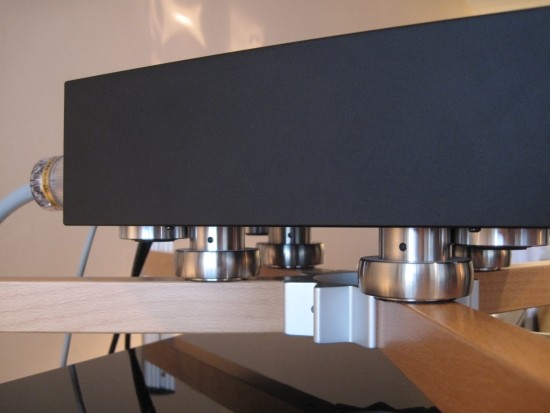
Above: The Clic sounded best when sat on Cerabase feet. The standard Spider rubber feet made for a too-soft delivery. Likewise the Clic was happiest with beefy sounding powercables and open and articulate interlinks.
Clic with iPhone 4 connected
While I’m in i-device mode, here’s how the Clic sounds with my iPhone 4. In a word: excellent! No really, I’ve heard plenty i-device docks and they definitely don’t all sound alike. Despite digital extraction, most tend to sound somehow artificial and restrained. The best thus far was the Wadia 171i and second best was the Naim UnitiQute. The Clic is at least at the same level as the UnitiQute. There’s just no artifice or clinicality whatsoever. I think that some sort of (accidental) synergy is going on here: the Clic’s slightly blurry bass and smooth treble nicely compensating for the iPhone’s inherent slightly thin and dry character. The result is highly enjoyable sound that is different, but pretty much comparable in subjective quality to the Clic playing from the Synology NAS. When splitting hairs, you could say that the Clic sounds less neutral with the iPhone than from the NAS, but for me it sounds more interesting and harmonically more complete with the iPhone. How that for a little controversy?
Clic compared to Computer replay
(and a quick comparison to the Levinson 360S DAC)
This is an interesting test. What I will do isn’t probably very consistent, nor does it say much, but hey, it’s fun! I will compare the Clic’s coaxial digital input to its network connection. For this I will use the same audio file from the same Synology NAS. The Windows XP computer runs Winamp 5, connected directly via kernel streaming to the HiFace EVO USB-SPDIF interface, then via Belden RG59 coaxial cable directly into the Clic. Even though the source of music was the same, there was a very large difference. Streaming music through the Clic made for the now familiar very refined but somewhat restrained sound quality. Nothing wrong with it, but also not very entertaining. Then, switching to the Wimamp5 derived signal, all of a sudden it’s like the Clic had a good night’s sleep and is now awake! Now, there’s the wide soundstage, the bass articulation and dynamics, the sense of overall involvement that I have been missing since I started playing with it. What’s more, a comparison with the same source into the Levinson 360S DAC showed the latter’s superiority, mostly in terms of bass fullness, soundstage and drive, but the Clic wasn’t that far off. How can this be? Is the Clic’s streaming functionality of lesser quality than its DAC? Or do the iphone and the Winamp/EVO-interface pairing all add their own harmonic coloration to the whole? I wouldn’t dare say.
Clic compared to Linn Klimax DS
On to the ultimate comparison then. David versus Goliath. Musical Fidelity Clic versus Linn Klimax DS. Unfair? You bet. But the Clic has a surprise up its sleeve. Just to be clear though: this isn’t the latest version Klimax: it is the first version without Dynamik power supply and with the older board, now known as Klimax DS/0. Still, this was the unit that climbed the charts in all audio magazines that reviewed it. Now that I have it, I can see why. Still, the DS isn’t universally better than the PS Audio PWD, nor does it beat all CD players in the world per se. But it is indeed very good. The specifics are more for a separate review, but know for now that the PWD is better in the bass and has more drive (it is Wadia-like in that area), while the Klimax DS is more refined, more transparent and a lot smoother. Now where does the Clic have its place? Funnily enough, the Clic’s treble is again found to be faultless and the DS doesn’t even better it in that respect. Perhaps the Clic is even airier. But the Clic’s advantage stops there, with the DS beating it in the areas of transparency, detail, speed, dynamics and bass articulation. And although the DS has to bow its head to the PWD in this respect, the DS does have fuller and more incisive bass than the Clic. But let’s throw in one more parallel, to try and forget all about the DS’s superiority: the Clic is comparable in neutrality to the Klimax DS. Both streamers are neutral enough to show weaknesses in recordings. Both do little to “cream up” the sound. If a recording is mediocre, it will sound mediocre. But if the recording is great, it will sound great.
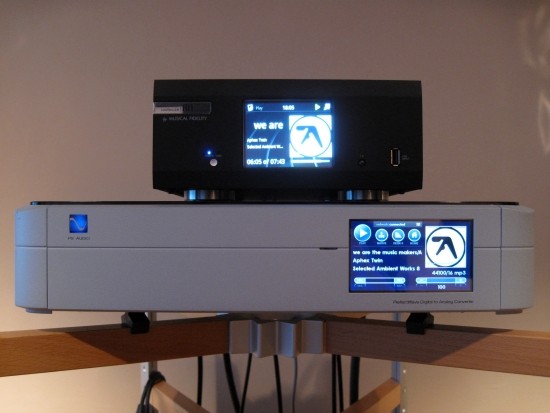
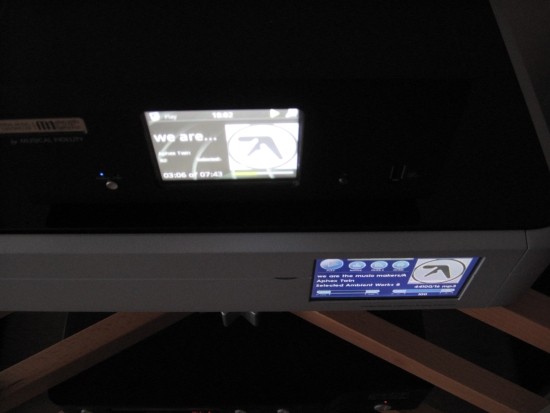
Above: same lighting conditions but different angle
Display Quality
While the front panel display is nice and bright, it does lack contrast. There’s no real blacks all text is a little fuzzy. Additionally, the viewing angle is very narrow. It is clearly legible though, and in no way does this obstruct operation, but a comparison with the PWD illustrates the point.
Some more minor nibbles
Seeking within a track is not supported. That’s not exceptional though, since so far, only the Klimax DS and PS Audio PWD offer this. There is no direct input selection: everything goes via the front panel display and the IR remote’s arrow keys. This can be a little cumbersome. Navigation through music lists is a little slow and when keeping the arrow button depressed, at some point speeds up, but then goes so fast that you can’t read the titles anymore. You can’t jump to any particular artist or song (for example by pressing the beginning letter). There’s no option to cue a song or even make a playlist. All that’s offered is direct play of any track, and consecutive tracks within that directory. The eLyric app can make a playlist, but playback only advances to the next track up as long as the app is running and the iPhone/iPad is switched on. There is however a favorites list, to which you can store tracks and recall them from.
Update 26 nov 2011: distributor Viertron indicated that a dedicated App is being worked on.
Conclusion
The Clic offers a unique set of abilities and has an effortless and relaxed quality to its sound. PRAT is not outstanding, but good enough. The Clic is definitely not slow, with plenty of speed and openness in the midrange, but bass can be a little soft and lacking body. Overall, the Clic doesn’t really have a specific character, which is a good thing for many people. Its delivery is not super-enthusiastic and shiny, but neither is it dark or boring. While not having the most expansive soundstage, the Clic has a slightly relaxed, but positive delivery and is open and airy, and all things considered, manages very well. It offers a lot of functionality but doesn’t stand out as a streamer, in that respect I prefered the Naim UnitiQute for its enthusiasm and better interface (both menu and i-device app). But the Clic’s DAC quality (in essence it is the M1 DAC), as evidenced by the digital computer replay, is really excellent and in fact, judged on that merit alone, I wouldn’t know of any other DAC in this price range that would outclass it. So, all in all it comes recommended, but with a reservation on the streaming part.
Update 19-12-2019
Stream Unlimited have not been sitting still and they still issue streaming audio modules. The lastest incarnation that I tested was in an Ayon S10-MkII Signature with Roon compatibility and it sounded fantastic.
